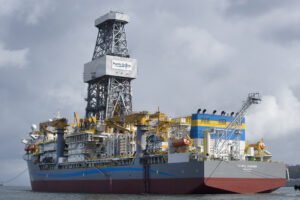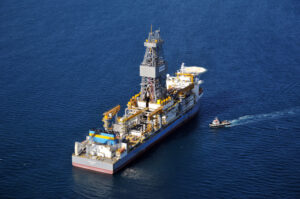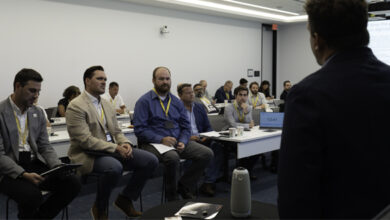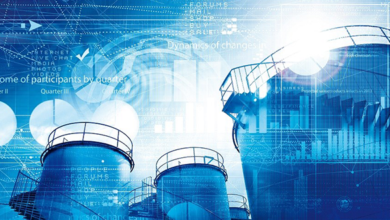Measuring gaps in time, productivity can address flat spots along critical path, ensure optimal rig performance

Pacific Drilling’s Bernie Wolford: Drilling/tripping times matter, but industry can realize significant benefits by looking more closely at what happens in between
By Linda Hsieh, Editor & Publisher
Bernie Wolford is CEO of Pacific Drilling.
Looking across your rig fleet, what do you see as the biggest challenges that offshore rig contractors now face?

Of course, the market remains very challenging from a demand perspective, although 2019 was an improvement and 2020 is poised to be even better. For Pacific Drilling, the biggest challenge is maintaining discipline in our approach to the market as it relates to the ramp-up of our smart-stacked rigs. We must be disciplined in the way we rationalize bringing assets back to the market.
A related challenge is that our equipment providers don’t have the same capacity that they had in the past. So, with the uptick in utilization that we’ve seen over the past six months, we are already seeing lead times for the most sought-after items extending to a year or more. The industry as a whole faces potential challenges around critical capital spares and the most sought-after upgrades. At this point, it’s not affecting our ability to deliver rigs, but it does require more advanced planning even as we’re facing continued uncertainty in the market.
Additionally, we’re starting to see a shift in client behavior – going from a short-term contracting strategy to a medium- or longer-term strategy. This means they’re going from one or two wells to a year or more. Along with this change comes an adjustment in market dynamics and a need to plan for longer time frames between rig availability for surveys and major maintenance.
Does it look like offshore drilling is really heading into recovery mode now?
Clearly there are a number of tangible measures supporting a “yes.” You can see the rate of operators taking FIDs is increasing, and subsea tree manufacturers continue to add to their backlog. Then you look at improving rates in recent fixtures, the number of open tenders and the fact that contract terms are starting to get longer. Combined, these are tangible indications that there is some positive momentum in place.
What challenges come to mind for you when the industry talks about automation and digitalization?
I think we still need to better define the problem we’re trying to solve. I’m not arguing the value proposition of digitalization or automation technologies but rather the need to invest where it delivers tangible value with sound near-term economics.
I think we oversell the benefits of data as a generalization. Of all the drilling data produced daily, we probably use something like 20%. But why do we only use 20%? Probably because we haven’t figured out how the other 80% really creates value. It takes resources and a longer time frame commitment to invest in the initiatives where you can produce actionable data.
For example, look at HSE-related data. It’s one thing to know that most of your injuries are hand and finger injuries. Then, looking at a variety of potential contributors, identifying patterns and suggesting impactful actions is not a trivial undertaking.
In the early days of digitization, I think some companies produced data because it had a sales value, but we’ve exhausted that initial halo effect. We and our clients now want to see that we are using data and analytics to support proactive measures.
Is there any specific area where you would like to extract more value from data?

There’s definitely room for using analytics in safety and to reduce injury exposure. At Pacific, we’re also looking at applying digital technologies and data to support strategic decision making, particularly in the area of marketing. This means using multiple sources of data to provide meaningful insights for key decision-makers in marketing and finance.
We’re now in a position where we can use data analytics to make better decisions about where to deploy units longer term, at what rates we should be offering those units, and how that ties to a longer-term strategy around the development of the market going forward. If we can better use data to minimize the gaps between drilling programs, that can go a long way toward establishing profitability.
What about using drilling data to improve drilling performance?
I think downhole data from the drill bit is being fairly well used today. I’m referring to data that might be coming from an MWD, the top drive control system or mud pump pressures, for instance – the things that influence the actual physical drilling performance. We’re seeing software and process automation systems now in the market that help us leverage that data into actionable improvements.
But a well is more than drilling. It is a project that may start years before drilling ever begins. It involves the supply chain, as well as logistics and integration of the key service providers, all culminating with everyone and all the equipment showing up at the rig site with a plan.
I believe it’s the data that would help us eliminate currently accepted flat spots along the critical path that’s not being used as much as it could be. In other words, data that could improve the quality of our planning, readiness and execution on the rig. As much as tripping times matter, it is only a small fraction of the total well construction process.
Sometimes an hour or two can be wasted without realizing it. People look like they’re busy, but they’re not actually advancing the well construction. They’re busy getting ready to advance the well construction. But all the “getting ready” part should take place offline.
The well construction project is very much an assembly line-like process. There are only a few things happening on the critical path at any given time, but there are 20 or more other activities supporting that critical path. There is waste if your critical path must be slowed because something else in the process can’t keep up, if certain items aren’t showing up fast enough, or if when all parts are ready and the competency and communication are not sufficient to get the job done efficiently.
Other industries have done a lot to track their processes and automate, so the system will tell them when they’re not performing at optimal levels. There are opportunities for the drilling industry to do the same.
Earlier you mentioned that you think our industry uses only about 20% of the data we have. So what do you see as the main barriers to increasing that percentage?
There are a lot of challenges around the sharing of data. Companies may adopt a position that data should be constrained so that others can’t derive competitive advantage, but I think the reality in drilling is that having access to the data is not the competitive advantage. Instead, how you use the data is the real competitive advantage.
The challenge is around encouraging the primary well construction parties – the operator, the driller and the large service providers – to have an open data platform. You can have strict limitations on using the data after the program is finished, but prior to and during the execution, everyone should have access to the same data so we are each able to contribute. It encourages fewer silos and promotes more insight. We can identify the data that has the most impact, and we can all be looking ahead to plan for the next steps.

Generally, we are leaving this opportunity on the table when we don’t put more effort and resources into sharing all relevant data. Ultimately, the operator will have to facilitate data sharing to capture these opportunities.
Do you think drilling contractors need to evolve to a different business model, other than dayrates, in order for them to gain more value from their performance improvements?
For starters, I’m of the belief that when we drill faster, we’re not working ourselves out of work; we’re working ourselves into more work.
If a well was financed to be delivered in 60 days but we drill it in 54 days, the common complaint is that you have worked yourself out of six days of dayrate, and that benefit accrued only to the operator.
That’s true when measured on one well. But when you consider that we compete with unconventionals, we compete with shallow water, and we compete with other forms of energy, then by delivering lower-cost wells, we’re actually enabling the operator to justify additional capital investments in the type of wells we drill. When you think about these huge projects in places like South America, East and West Africa, the savings can add up and make a difference in whether the operator sanctions earlier or further development.
You have to accept that the world will become more efficient. For those of us focused on deepwater drilling, we must do what we can to enable deepwater to be competitive.
What I would say regarding the current dayrate model is that there are available bonus and penalty models that do work when ideally constructed. There’s been a problem historically with skin-in-the-game models, where the driller may suffer due to downhole conditions that, for example, required another casing string to be run. For instance, the driller did everything right, yet the well was still 10 days late because we encountered a salt layer or a water flow and, as a result, recovered less incentive. An overly simplified provision creates a lack of balance that serves to make the incentive less impactful or motivating.
Are you happy with current KPIs used in the industry to measure drilling contractor performance, which tend to measure how fast something is done?
I think operators do need to keep measuring what they’re measuring, but we need to share that data and feedback as near to real time as possible and layer on a continuous improvement process to capture learnings and facilitate improvement. Don’t tell us how we performed at the end of the well, or even a week after the fact. If we are sharing the data in near real time with the people who are executing the work and then supporting those same persons in improving, we can create continuous improvement.
Secondly, I would go back to the hidden or accepted flat spots that I mentioned earlier. We should be measuring those gaps in time and productivity, as opposed to just how fast you go once on path. How long did it take you between the finish of this event and the start of the next event? I don’t think that’s visible today.
How do you think the role of drilling contractors has evolved over the past decade?
If you’ve been in the business as long as I have, you would argue that certain things haven’t really changed. First and foremost, you’re managing people, you’re managing risks, and you’re managing performance.
What I think is changing is operators no longer see the role of the drilling contractor as simply providing a reliable rig with as little downtime as possible; we’ve evolved to a point where it’s a given that you’re not going to have a lot of downtime. Instead, operators are recognizing that there’s real value in having the drilling contractor be a critical part of their daily planning, two- or three-day look-ahead and continuous improvement cycles.
If you identify a really top-performing rig – somehow there’s a secret sauce working amongst that crew. They know their job, they are constantly planning ahead, and the “getting ready” is always happening. That’s why rigs that work for one operator for multiple years can deliver incredible performance, because everybody knows their next move. In this market, there are not a lot of longer-term contracts anymore, so that means we have to do more to compensate for that lack of long-term continuity.
Over the past decade, the drilling contractor has also become a critical partner for the operator in terms of assurance and risk management. It’s now widely recognized that the ownership of risks and the assurances that those risks are well managed have to permeate deeply into the drilling organization. Operators depend on our systems of assurance and our systems of management like never before.
What changes do you foresee for the next decade then?
Because we own the largest asset on location, we will be the natural implementer of automation on the rig. There has been some headway to furthering automation, but over the past four to five years, there’s been a lag in substantive progress.
I think the next leg of automation will be to get the machines to really interact with each other and hand off work, machine to machine, without a human as the middle man. For example, pipe rackers are mechanized, but they’re not automated. Today you see some people doing automated tripping; next step, how do we automate getting casing from the casing rack to standing vertical on the rig floor? Currently there are multiple men in the middle.
I believe this kind of automation is coming in the next generation of rig equipment, but current economics are far from supporting it.
“In the early days of digitalization, I think some companies produced data because it had a sales value, but … we and our clients now want to see that we are using data and analytics to support proactive measures.”
When do you think the industry will see another round of capital investments in next-generation equipment?
I don’t think that’s something we can plot on a calendar. It will be whenever it makes financial sense, and there are simply too many moving parts to predict. It will be when we think a multimillion-dollar investment in automation will pay itself back in a high-certainty time frame. Right now, the market does not lend itself to major automation investments.
Many operators are asking drilling contractors to enhance their environ-mental stewardship. How do you think contractors will respond to this trend in the coming years?
First, through better fuel efficiency and thereby reduction of carbon emissions. Drillships burn a lot of fuel each day. If you can save 5-10% of 30-40 tons of fuel a day, that’s significant.
As a first step, a number of drillers are going to closed-loop bus systems on DP rigs, which allow for more flexibility in terms of how much spinning reserve you have on the line, meaning engines running at any given time. On a typical drillship, you have three independent power buses, and each bus must have at least one engine running. They are isolated from one another to reduce blackout risk.
Now, advances in control software are allowing us to connect these buses and more efficiently manage spinning reserve.
We will also see people working on peak shaving, using battery packs to supply the extra energy you might need for a few minutes when you’re picking up a 600,000-lb drill string to make a connection. Again, this allows you to have fewer engines running while still being productive.
On the next generation of drillships, I believe we’ll also be able to recapture energy when lowering the drawworks. Currently, that energy is being turned into heat only. The next generation of drillships will be able to recapture the majority of that energy.
What else do you foresee for the next generation of drilling rigs?
I think they will be designed to eliminate human exposure to work processes. A classic example is riser running. These risers are huge; when the rig moves, they go where they want to go, and people just have to stay out of the way.
Right now, with nearly every rig in the world, halfway down with each joint, you have to stop, and a person will walk out to the riser, take the MUX cable and secure it in a rubber clamp, then clip the rubber clamp to the choke and kill line on the riser.
This is just one example of a process that the next generation of drillships will automate. Overall, I think energy conservation and less manual intervention are going to be what differentiates an eighth-generation rig from a high-spec seventh-generation rig.
How can drilling contractors cooperate more effectively among themselves in order to improve overall performance for the industry?
We need to look at the success of the RAPID-S53 joint industry project (JIP). It is one of the finest examples of the industry recognizing a problem, taking ownership of that problem and developing solutions that are benefiting everybody in the value chain. Its benefits include less downtime, less exposure to injury for BOP pulls, less time to drill the well and a higher level of process safety assurance.
In my opinion, that’s an incredible achievement by people who devoted their time, energy and ideas to develop a collaborative environment. We should be doing more of that kind of problem solving as an industry.
We’re doing something similar now through IADC – implementing formal methods of assessing subsea engineering qualifications on a consistent and economically sound platform. When finished, this work will also accrue benefit to all involved.
I don’t know the next problem that we’ll solve in this way, but there will be one. Maybe it will be how we can reduce the carbon footprint on drilling rigs. In all cases, there may be resistance at first, just like in the early days of S53. Initially, people may not join due to lack of resources, low confidence in the outcome, perceived risks of working as a group and lost competitive advantage.
But I don’t see reducing the carbon footprint being a sustainable competitive advantage for anyone. Rather, it’s going to be a condition of survival for our industry. It seems like a natural next step for a more collaborative effort. DC





